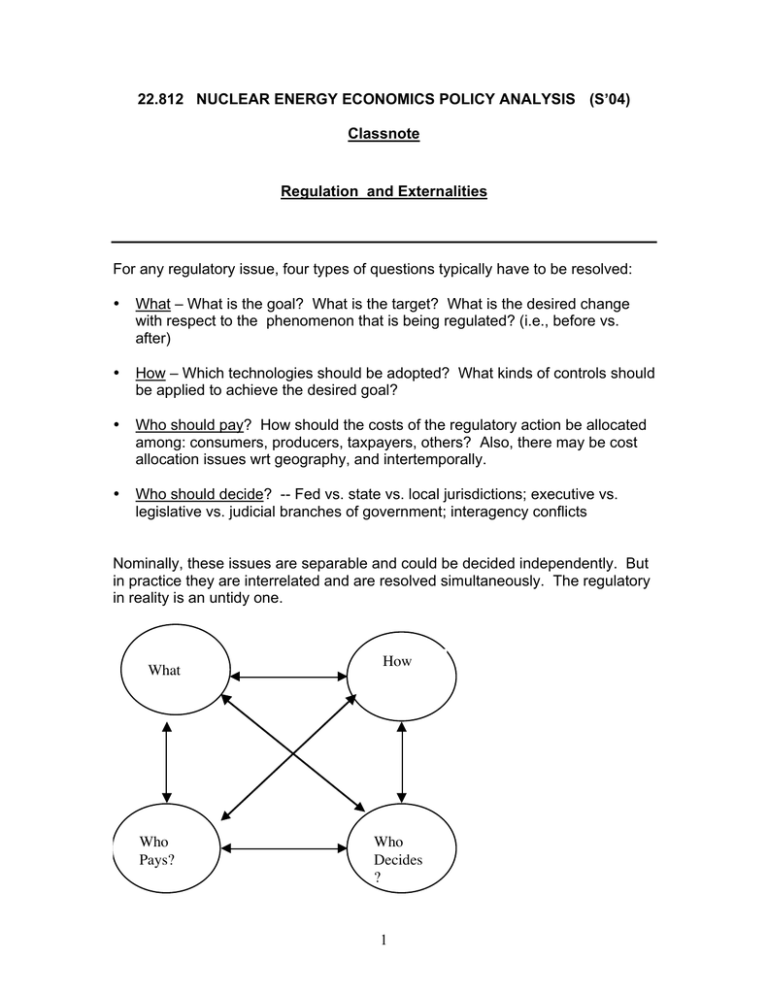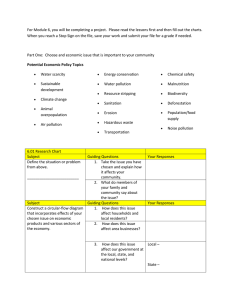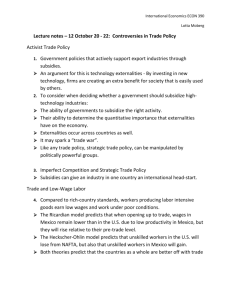22.812 NUCLEAR ENERGY ECONOMICS POLICY ANALYSIS (S’04) Classnote
advertisement

22.812 NUCLEAR ENERGY ECONOMICS POLICY ANALYSIS (S’04) Classnote Regulation and Externalities For any regulatory issue, four types of questions typically have to be resolved: • What – What is the goal? What is the target? What is the desired change with respect to the phenomenon that is being regulated? (i.e., before vs. after) • How – Which technologies should be adopted? What kinds of controls should be applied to achieve the desired goal? • Who should pay? How should the costs of the regulatory action be allocated among: consumers, producers, taxpayers, others? Also, there may be cost allocation issues wrt geography, and intertemporally. • Who should decide? -- Fed vs. state vs. local jurisdictions; executive vs. legislative vs. judicial branches of government; interagency conflicts Nominally, these issues are separable and could be decided independently. But in practice they are interrelated and are resolved simultaneously. The regulatory in reality is an untidy one. What Who Pays? How Who Decides ? 1 Criteria for Success in Regulation n Improvement in the situation that is being regulated. n Equity – there are different definitions of what this means, but in general, we might say that equity means that the beneficiaries of whatever activity produces the effect that needs to be regulated should also bear the cost. n Efficiency – whatever the level of protection/amelioration sought, it should be achieved at minimum cost. Regulatory Efficiency A useful way to think about regulation is that it is concerned with activities that impose costs on society that wouldn’t otherwise be taken into account in producer investment and pricing decisions. In other words, it is concerned with external costs. For coal-fired power generation, for example, this includes CO2 and NOx as well as SO2. For wind power generation, this may include environmental impacts like noise and visual pollution, etc. We can use an economic framework to explore the consequences of these external costs. Let’s take as our starting point the situation before the external costs are taken into account. In principle, market competition offers a decentralized mechanism of unmatched efficiency for determining the optimal level of output of a given product or service and the mix of production technologies used to supply it. Individual producers who are competing with each other to supply customers decide how much product to produce, how to produce it, and what price to sell it at, based on their knowledge of their production costs and the prevailing price in the marketplace for that product, with their decisions driven by the objective of profit maximization. For their part, individual consumers decide how much of a given product to consumer based on its market price, and the value or utility they assign to the product relative to other goods and services they may wish to consume. The fundamental proposition is that the aggregate outcome of these countless individual decisions made by producers and consumers on the basis of the information conveyed in prices set by competitive markets will be socially optimal 2 – that is, the result will be to produce the maximum benefit to society at the minimum cost. And in general that outcome will be superior to that achieved by a central ‘command and control’ mechanism for setting prices and output quantities (this is the ‘invisible hand’ at work.) Historically, of course, the electric power industry has not operated this way at all, though with economic deregulation it is moving towards this. For the moment, let us assume that decisions on output and pricing are made through market competition. Now let us introduce external costs -- costs that are associated with the production process that are not taken into account by producers when they make their production and pricing decisions, and hence are also not taken into account by consumers when they make their purchasing decisions. This can be thought of as a form of market failure. From this perspective, the problem with, say, SO2 emissions from fossil fuel plants, or visual pollution from windmills, is that there is no market for the use of the ‘resources’ that these impacts are depleting, i.e., visual beauty and clean air. And because there is no market for these scarce resources, the producer doesn’t have to pay to use them (let us, for the moment, assume that there is no regulation of their use), and that is why the costs aren’t taken into account in the producer’s production and pricing decisions. The result is that excessive (i.e., above-optimal) pollution will occur. Producers will underinvest in pollution abatement, because the pollution is free, and consumers will consume more of the product than is optimal because the price that is paid doesn’t include the cost of the pollution. P Supply curve Demand curve Another way to say this is that the scarce resource – scenery, clean air, etc. – has been misallocated because of the absence of a market in the right to use it. 3 In order to correct for this ‘missing market’, society has to find a way to internalize the external costs, i.e., to force the owners of the polluting plant to take account of the effects of those impacts in their investment decisions, and hence also to force consumers to take account of them, in effect by paying for them. This is what is accomplished by regulation. The effect of regulation is to internalize costs that were previously externalized in production and consumption decisions. The standard way to achieve this is through mandatory abatement measures. These take various forms, for example: • Mandatory controls on technology (e.g., mandatory use of cooling towers, or stack gas scrubbers to remove SOx, or nuclear reactor safety systems.) • Mandatory fuel use requirements (e.g., use of coal with a sulfur content lower than a certain level, or use of gasoline with a specified oxygen content.) • Mandatory emissions limits on specific pollutants an individual facility • Mandatory emissions limits on a population of facilities It is important to note that the effect of such regulations is not to eliminate external costs. In general, there will be some residual emissions, safety risks, etc., even after the regulations have been fully complied with. This then leads to the concept of the total social cost of a given technology – the sum of the internalized costs and the residual external costs. In principle, we would like to select technologies with the lowest total social cost. In a pure market setting, it is only the internalized costs that are factored into market prices and hence resource and technology selection decisions. In recent years, especially in the electric power sector, attempts have been made to factor in the external costs too, in order to create a ‘level playing field’ among competing technologies. These attempts have taken several forms: 1. Some state public utility commissions and others have adopted policies that require electric companies to consider all impacts resulting from plant operation in the technology selection process, including air, water, solid waste, and other impacts, and in some cases prescribe the use of specific cost values for these externalities. The purpose is to select the technology with the minimum total social cost. Once this selection decision is made, however, the cost ‘adders’ applicable to the winning resource are not incorporated into price paid for by the electricity consumer, and thus full internalization is not achieved. 2. Another approach would be to tax fuels and/or technologies by an amount equal to the external costs of the environmental and health damages they 4 cause. This would fully internalize these costs, and in some cases (see below) would cause significant increases in the energy price. 3. Since such taxation is usually very unpopular, an alternative approach is to provide subsides to clean technologies where the subsidies are calculated on the basis of the external costs that they avoid. Each of these three approaches have different implications, and involve a different mix of administrative decisions vs. market choices. But in all cases the requirement is that the external costs be measured and monetized. Measuring and monetizing externalities Though the environmental, health, and other external costs associated with different technologies are real, they are often very difficult to quantify in economic terms. How to monetize, for example, the damage caused by acid rain on the ecosystem and biodiversity? How to monetize the aesthetic impacts of a windfarm in Nantucket Sound? Or its impacts on the bird population of the area? What is the appropriate monetary valuation of human mortality risk? What is the appropriate discount rate for effects which may persist for very long times? By how much should predicted deaths in the far future be discounted, if at all? Should a regulatory jurisdiction in one state apply the same cost penalty to instate and out-of-state externalities (or, as the California Energy Commission does, discount out-of-state externalities)? The attached tables and figures show the wide range of estimates that have been developed for external costs. One of the most comprehensive attempts to quantify externalities has been undertaken by the European Commission in its ExternE Project (see http://externe.jrc.es/ ). Footnote It is important to recognize that some private investment decisions may produce benefits to society that aren’t accounted for by the producers when they make these decisions, and that this, too, is a form of market failure. A good example is the external benefit associated with R&D. When a company does R&D, not all of the benefit is necessarily captured by the company itself. Some of the knowledge generated by the R&D effort may also become available to other companies, and may bring benefits to them and to their consumers that the original performer of the R&D can’t appropriate. If R&D-performing firms aren’t fully compensated for the true social value of the R&D, they will tend to underinvest in R&D relative to the social optimum.] 5




